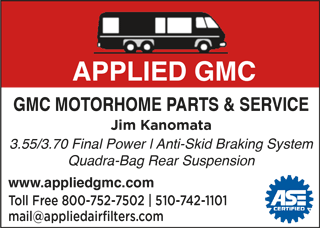Middle Age Spread
Information and ideas provided by intelligent and well-meaning members of the GMC community in hope that you will benefit from their experience. Accuracy is not guaranteed. Independent verification is urged.
Source: Emery Stora
When the GMC door has a gap at the top and at the bottom but the latch area makes contact it is easy to assume that the door has been bent. There is a section in the GMC Maintenance Manual giving details on how to recurve a door. Many GMCers have posted information that a door gets bent when it swings open hard against the side of the GMC outer wall by the hinges of the door. Apparently it can bend there when the rub strip on the door and on the sidewall hit; however, this does not explain why the latch side of the door often appears to be bent more than the hinge side. If the rub rail was doing the bending it wouldn’t bend more at the latch side.
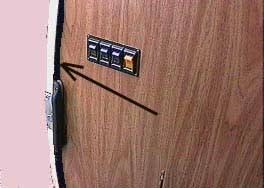 A few years after buying my GMC, I started to have problems with my door not sealing at the top and bottom and upon examining it I found that the wall by the latch side seemed to be pulling away from the cabinet wall by the side of the refrigerator. In fact, I had a 1/2″ gap between the outer curve of the cabinet wall and the inside of the GMC wall (Picture 1); and yet, the cabinet wall touched the GMC wall at the top and bottom which indicated to me that the cabinet was not pulling away from the wall.
A few years after buying my GMC, I started to have problems with my door not sealing at the top and bottom and upon examining it I found that the wall by the latch side seemed to be pulling away from the cabinet wall by the side of the refrigerator. In fact, I had a 1/2″ gap between the outer curve of the cabinet wall and the inside of the GMC wall (Picture 1); and yet, the cabinet wall touched the GMC wall at the top and bottom which indicated to me that the cabinet was not pulling away from the wall.
It is my belief that the wall of the motorhome has begun to bulge outward. I have termed this “Middle Age Spread”. The constant jouncing of the GMC aluminum body up and down with the weight of the air conditioner on the roof has probably caused this bulging over time. My fix for this is to pull the outer wall back toward the inside of the GMC and to bolt it to the cabinet wall to keep it in place.
To get the wall back into place it is necessary to either pull it back or push it back. If you have a kitchen window on the opposite side that opens you can cut two pieces of 2×4 lumber to fit across the openings. Make one long enough to fit across the door frame and the other long enough to fit across the window. Let them extend a few inches past the openings. I used a “come-a-long” winch to fasten to the 2×4’s and pulled in the wall by the door until the refrigerator cabinet wall nested back into the area adjacent to the door latch and the gap appeared to be tightly closed. Position the 2×4 near the center of the door frame by the latch and the kitchen window one just over the countertop. Fasten the cable of the winch to the 2×4 adjacent to the rear of the door opening next to the latch. Be sure to pad the outer wall of the GMC between the wall and the ends of the 2×4. I used some cloth and then a piece of 1/4” plywood to spread the force.
If you don’t have an opening window on the opposite side from the door you could park the GMC next to a concrete wall, a strong tree or a telephone pole and use a jack between the wall, tree or pole and the side of the GMC by the door latch. Again, be sure to use some padding to protect the wall and some plywood to spread the force and to keep from pressing a dent into a small part of the outer wall.
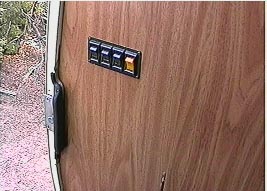 Once you have the wall pulled back against the curved side of the cabinet (Picture 2) you have to fasten the outer wall to keep it in place. Do not release the tension on the winch or jack until you have bolted the wall into place.
Once you have the wall pulled back against the curved side of the cabinet (Picture 2) you have to fasten the outer wall to keep it in place. Do not release the tension on the winch or jack until you have bolted the wall into place.
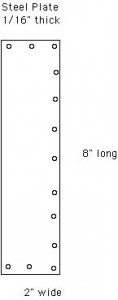 Since the cabinet wall is pressed wood it is not very strong in tensile strength and in order to bolt to it and have it hold, I made up a 2” x 8” piece of steel about 1/16” or more in thickness. I drilled 1/8” screw holes around the two short sides and one long side about 1” apart (Picture 3). To gain access to the inside of the cabinet wall you can reach through the outside refrigerator vent opening and remove some insulation on the right side toward the door. I centered the metal plate vertically on the center of the latch. It was positioned flat against the inside of the cabinet wall with the two outer corners of the plate just touching the outer curve of the wall. I screwed the plate to the inside of the cabinet wall using coarse thread screws (often called “deck screws” or “wood bullets”). These will hold well in pressed wood without removing too much wood as they are screwed in. After the plate is in place I drilled two holes through the door latch, the cabinet wall and the inner steel plate (Picture 4). The holes are 7” apart, centered on the door latch stud. The holes are place as close to the inner lip of the latch plate as possible but leave enough space to clear the screw heads. I used a small head screw in order to get them as far back as possible. The two screws are 1/4” diameter. They are fastened with a washer, lock washer and a 1/4” nut on the inside. After you have the two bolts tightened you can release the winch or jack pressure.
Since the cabinet wall is pressed wood it is not very strong in tensile strength and in order to bolt to it and have it hold, I made up a 2” x 8” piece of steel about 1/16” or more in thickness. I drilled 1/8” screw holes around the two short sides and one long side about 1” apart (Picture 3). To gain access to the inside of the cabinet wall you can reach through the outside refrigerator vent opening and remove some insulation on the right side toward the door. I centered the metal plate vertically on the center of the latch. It was positioned flat against the inside of the cabinet wall with the two outer corners of the plate just touching the outer curve of the wall. I screwed the plate to the inside of the cabinet wall using coarse thread screws (often called “deck screws” or “wood bullets”). These will hold well in pressed wood without removing too much wood as they are screwed in. After the plate is in place I drilled two holes through the door latch, the cabinet wall and the inner steel plate (Picture 4). The holes are 7” apart, centered on the door latch stud. The holes are place as close to the inner lip of the latch plate as possible but leave enough space to clear the screw heads. I used a small head screw in order to get them as far back as possible. The two screws are 1/4” diameter. They are fastened with a washer, lock washer and a 1/4” nut on the inside. After you have the two bolts tightened you can release the winch or jack pressure.
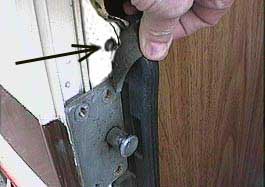 My GMC has had this fix in place for about 8 years now and it is still holding well and no longer has a gap at the top and bottom.. I have not had to bend the door and the door has never needed another adjustment since doing this.
My GMC has had this fix in place for about 8 years now and it is still holding well and no longer has a gap at the top and bottom.. I have not had to bend the door and the door has never needed another adjustment since doing this.

